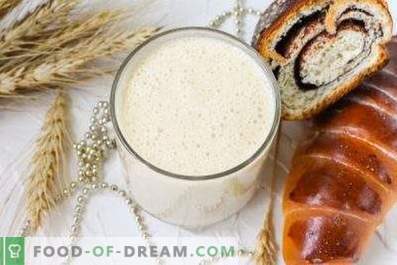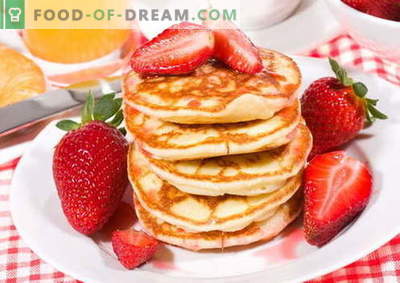
Yeast dough is used for most types of baking. They make pies and pies, buns and bread, pizza base, pancakes and many other products. The flour base on yeast can be sponge and straight. This term refers to the technology of the dough. Bezoparny way means that all the ingredients are mixed together immediately, without prior preparation of the leaven. The yeast dough bale is the starter set on yeast. Bakers often call it a starter. It is with its preparation that the process of kneading many types of flour bases begins, especially if there is a lot of baking in it (butter, eggs, sugar). Sponge yeast dough rises better, has a more pleasant taste, does not deteriorate longer. Therefore, it is this method that most professional bakers choose, who are proud of the fruits of their labor.
Cooking Features
The brewing techniques for yeast dough do not have large differences, and it does not matter for what kind of baking the flour base is prepared. The process consists of activating the yeast, their “feeding” with sugar, adding flour and waiting for the sponge to come. Outwardly, this algorithm looks simple, but when trying to make a dough for it, the novice cook begins to ask various questions, realizing that there are no trifles in the kneading process. How much yeast, sugar and flour? What should be the temperature of the liquid base and what can serve it, except water? How to determine that the opara came up? Only knowing the answers to all these questions, you can knead a good dough, which will come out delicious pastries.
- The amount of yeast for dough is calculated based on the amount of flour and the characteristics of the yeast itself. Typically, 50 grams of pressed yeast or 15-20 grams of dry yeast is used for 1 kg of flour. We are not talking about high-speed yeast, on which the dough is usually made straight way. But if you decide to make a brew on them, then for 1 kg of flour, use one bag of instant yeast (11 g) or more, if you want the brew to come almost instantly.
- A warm liquid will be required to activate the yeast. Usually it is water or milk, less often - whey or kefir. The liquid is heated to approximately 30 degrees, unless there are other recommendations on the package with yeast. If the liquid base is too cold, the yeast will refuse to work. Hot liquid can kill them altogether.
- Sugar for brewing is usually taken a little, but it should be enough to ensure the formation of carbon dioxide, able to raise the dough. Usually, 50 tablespoons of sugar are added to 50 g of pressed yeast, depending on how much sweet pastries they want. If the recipe test involves the use of more sugar, then it is added after the sponge is suitable.
- Opara can be liquid and thick. For bread and pies, they usually make a thick sourdough by adding half the prescription amount of flour. The dough for fritters and pancakes is often made liquid, for its preparation about a third of the prescription amount of flour is used.
- The remaining flour, as well as butter, eggs, and other ingredients combine with the brew after it is cooked.
- Liquid sponge comes up in about 30-40 minutes; thick sponge has to be ready for 2-3 times longer.
- An opara is considered approached when it begins to fall off after an increase of 2-3 times in volume. On the bubble surface of the dough at this time often there are cracks, which can accurately determine the need to move to the next stage of the dough.
- On the second-grade flour, the sponge fits faster, but the dough is not tasty, therefore experienced housewives prefer to use flour of the highest or first grade.
- Flour before mixing with other ingredients must be sifted. This is done not only to rid it of small litter and insect larvae. The main task is to saturate flour with oxygen: after sifting it becomes easy, it is easy to mix it with other components, preventing the formation of lumps. Opara on sifted flour fits faster. Delicious and airy pastries come out of the dough kneaded on it.
- When combining flour with other components that are part of the dough, it is necessary to stir the mixture until it is homogeneous; it should not be allowed to contain flour lumps in it.
- After mixing the ingredients, the container with the boil is covered with a cloth or cling film, put in a warm place. The higher the ambient temperature, the less will have to wait for the rise of the dough. The optimum temperature is about 26-28 degrees. The window leaf during the preparation of yeast dough can not be opened - it is afraid of drafts.
- Try not to miss the moment when the sponge approaches and it is time to add other ingredients to it. When it begins to fall, the fermentation processes in it come to an end, and it will soon begin to sour. If you do not knead the dough in time, it can become sour, and baking out of it will not be as lush as it could be.
The kneaded dough is not used immediately. They put him in a warm place and wait for it to increase in volume at least 2 times. Only then can it be crushed and used for its intended purpose.
Dough for yeast dough on water
Composition:
- pressed yeast - 25 g;
- water - 0, 25 l;
- sugar - 20 g;
- flour - 150 g.
Method of preparation:
- Water boil. Allow it to cool to 30-35 degrees. Pour into a bowl.
- Crumble the yeast in a bowl with water, add sugar. Stir until yeast and sugar dissolve.
- Wait about 10 minutes for the yeast to start working. This will indicate the appearance of foam caps.
- Sift flour, combine it with a liquid composition. Stir well to avoid lumps in the finished mass.
- Tape a bowl with cling film, make several small holes in it with a toothpick so that the sponge does not suffocate.
Put the bowl in a warm place and wait until the sponge rises and begins to fall. Connect it with the remaining components, knead the dough. Pressed yeast in this recipe can be replaced with ordinary dry, it will be enough one standard sachet.
Dough for yeast dough in milk
Composition:
- wheat flour - 0.5 kg;
- milk - 0, 3 l;
- sugar - 40 g;
- pressed yeast - 50 g (or 20 g dry).
Method of preparation:
- Sift flour.
- Heat the milk to about 30-35 degrees, pour it into a bowl. Pour sugar into it and stir to achieve dissolution of the crystals.
- Add yeast to warm milk. If you use extruded, they need to crumble or stretch your hands. Stir products.
- After dissolving the yeast, wait a bit to make sure that they are activated.
- Add flour and stir.
Sponge according to this recipe will be thick. Wait until it fits, it will take 2-3 hours. But this starter is suitable even for a sweet dough, which usually rises quite hard. To make buns from this brew, you need to add 5-6 eggs, a glass of sugar, 300 g of melted butter or margarine, half a teaspoon of salt and another half a pound of flour.
Quick dough for instant yeast
Composition:
- wheat flour - 0, 25 kg;
- high-speed dry yeast - 11 g;
- milk - 0, 25 l;
- sugar - 20 g.
Method of preparation:
- Heat the milk to about the temperature of the human body.
- Mix yeast and sugar with sifted flour.
- Stir until smooth.
- Put the bowl with brew in a warm place and wait a bit - it will fit in just half an hour, maybe even a little earlier.
It remains to add the rest of the ingredients listed in the recipe to the dough, add 250 g of flour to the heap and knead the dough. It also rises quickly - in 20-40 minutes.
Opara for yeast dough is made easy, you just need to be patient and wait until it fits. This method of cooking flour bases most often choose if they want to bake bread or baking.























